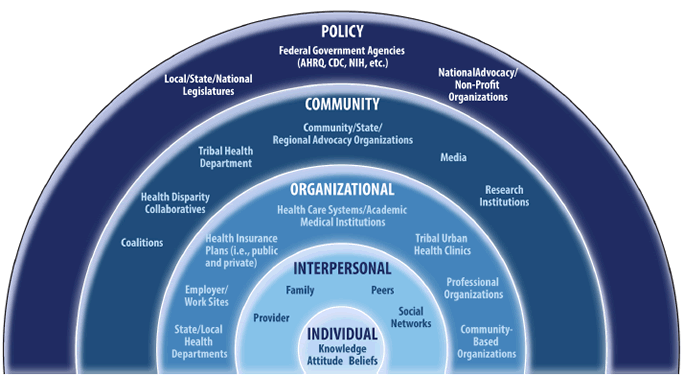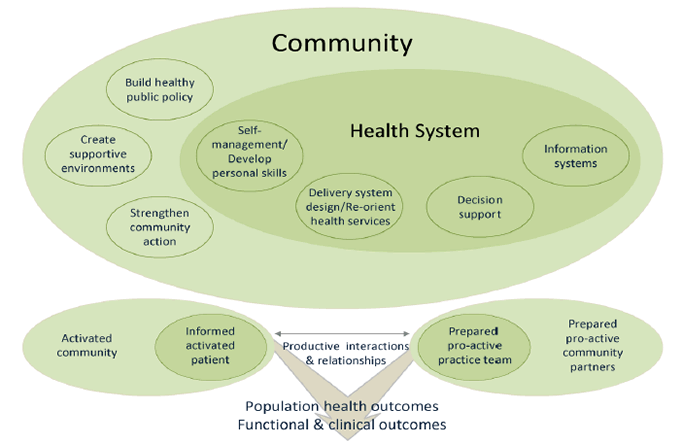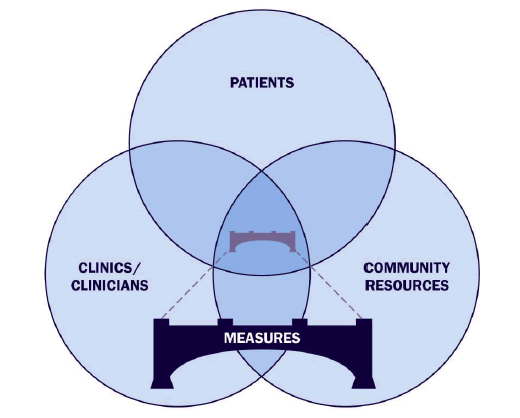3. What Is the Clinical-Community Relationships Measurement Framework?
This chapter contains:
- An overview of the Clinical-Community Relationships Measurement (CCRM) Framework.
- An explanation of the larger context within which the framework exists.
- A description of the foundation and contents of the framework.
3.1 Overview of the Measurement Framework
The Measurement Framework is a conceptual framework for the Atlas that provides a structure for identifying, categorizing, and understanding the basic components of effective relationships between primary care practices and community resources for providing certain clinical preventive services. The framework is organized around a series of measurement domains that can provide the basis for empirical assessments of the structures, processes, and outcomes of the relationship at the practice or community level.
The theoretical basis for the measurement framework presented is twofold. The Etz bridging model (Etz et al., 2008) and Donabedian's structure-process-outcome model (Donabedian, 1980) provide the foundation of the measurement framework.
Etz's bridging model describes a set of characteristics on the clinic/clinician side of the "bridge" that influences the ability to initiate connections to community resources, and a set of characteristics on the community resource side that facilitates connections to primary care practices. These attributes can be considered foundational anchors that must be established on each side of the bridge for a clinical-community relationship to be developed. The measurement framework expands on this model to take explicit account of the patient role and relationship with both the clinic/clinician and the community resource sides of the bridge. The patient, clinic/clinician, and community resource elements and the relationships among these elements form one dimension of the measurement framework. A more detailed explanation of this bridging model is given in Section 3.3.1.
For the purpose of examining clinical-community relationships, Donabedian's structure-process-outcome model has been applied as the second dimension used to categorize measurement domains within the measurement framework. This approach allows measures of structure, process, and outcome to be considered and examined for the clinic/clinician, patient, and community resource elements and for the relationships between these three elements.
Table 3-1 presents the measurement domains within the clinical-community relationships measurement framework. Brief definitions of the measurement domains are listed in Table-3-2.
3.2 The Context of the Measurement Framework
We recognize that the core elements of the framework—the clinic/clinician, the patient, and the community resource—exist within a broader context that includes many other influential factors.
The effects of each of the framework's elements and the interactions between them should be understood within this broader context. However, there was no attempt to include all aspects of the broader policy environment in the framework, nor is the framework a comprehensive model for the entirety of primary care. Rather, it is a way to understand, assess, and improve the functioning of an approach to the delivery of preventive services that is consistent with the direction of national policy and strategy, and is likely to be responsive to the needs of patients.
We recognize that preventive health screenings may occur in a large variety of settings including faith-based organizations, supermarkets, senior centers, and others that do not involve a referral from a primary care clinician. This Clinical-Community Relationships Measures Atlas represents the first phase of a multi-phase endeavor. While we acknowledge the need for measures of different types of clinical-community relationships, our focus in this first phase is on measures of clinical-community relationships for the delivery of certain preventive services where the referral to the community service is initiated in the primary care setting.
Because each community is unique, the utility and relevance of the measure domains that fall into the three elements of the framework may differ from community to community. Communities differ in population size, wealth, educational attainment, cultural diversity, the challenges they face, and their approach to addressing those challenges. The specific health and community resources available and accessible in each community are unique and may logically influence the relationships between the clinic/clinician and patient elements.
The patient element exists within a broader socioecological model, as illustrated in Figure 3-1. Individual characteristics of patients, the influence of their family structure, the control of work space and organizational environments, and broader community policies all have an effect on the individual patient.
Figure 3-1. Socioecological model

Division of Cancer Prevention and Control, National Center for Chronic Disease Prevention and Health Promotion. (2011). Social Ecological Model. Retrieved September 21, 2012. From http://www.cdc.gov/cancer/crccp/sem.htm.
Providing a broader context for the clinic/clinician element, the Expanded Chronic Care Model (Barr et al., 2003) depicted in Figure 3-2 recognizes that patient-centered interaction is not limited to the one-on-one encounter in the exam room. The clinician is supported by a team of health professionals whose roles are diverse. Some provide care management or care coordination; some serve as boundary spanners between various resources; and some help patients navigate the complexity of the health system. In Example 2, from Section 2.1, clinicians engaged the assistance of Community Health Educator Referral Liaisons (CHERLs) to help manage their clients and orchestrate their clients' preventive services.
The model for clinical-community relationships illustrated in Figure 3-3 can be thought of as a way of re-conceptualizing the interactions between the components of the system labeled informed activated patient, prepared pro-active practice team, and prepared pro-active community partners in Figure 3-2.
Figure 3-2. Expanded chronic care model

Barr, V. J., Robinson, S., Marin-Link, B., et al. (2003). The Expanded Chronic Care Model: Integrating Population Health Promotion. Retrieved September 21, 2012. From http://www.longwoods.com/content/16763.
In sum, the measurement framework is an attempt to provide an overall description of the factors that may influence clinical-community relationships for the purpose of providing certain clinical preventive services. As noted above, the particular characteristics that may influence clinical-community relationships vary from community to community. For this reason, the elements of the framework that are relevant or useful, and the measures that arise from the framework, would be expected to vary accordingly. This framework should not be construed as a checklist to be completed the same way in every patient or every primary care practice, but rather as a guide for clarifying the specific category or categories of measures that are relevant in particular circumstances.
3.3 The Foundation of the Measurement Framework
This section describes the foundation of the measurement framework that is presented in Table 3-1. The theoretical work that supports the framework is further discussed, as well as the rationale for how different types of measures are conceptualized and organized in the framework.
3.3.1 Expanded Bridging Model
Figure 3-3 depicts the foundation of the framework. The three interconnected circles in the Venn diagram represent the three principal elements of the framework—the patient, the primary care clinic/clinician, and the community resource. The patient element is defined as the individual who receives primary care services, including preventive care and illness care; this definition includes family members and/or others directly responsible for the care of the individual. The clinic/clinician element includes individual clinicians and clinic support staff operating in clinical settings in which primary care is delivered. The community resource element encompasses a range of organizations and programs that provide services to patients.
Figure 3-3. Foundation of the measurement framework for clinical-community relationships

Imposed over the diagram is the Etz bridge (Etz et al., 2008), which connects the clinic/clinician and the community resource. According to Etz et al., the concept of a bridge "suggests a dynamic and interactive connection as well as the need for strong foundations, for knowledge of local landscapes, and for continuous maintenance" (2008, p. S391). Etz's bridging model describes a set of characteristics on the clinic/clinician side that influence the ability to initiate connections to community resources, and a set of characteristics on the community resource side that facilitate connections to primary care practices. These attributes can be considered as foundational anchors that must be established at each side of the bridge for a clinical-community relationship to be developed. Anchoring characteristics on the clinic/clinician side include the capacity to assess patient risk, ability to provide brief counseling, capacity and ability to refer, and awareness of community resources. Anchoring characteristics on the community resource side include the availability, accessibility, affordability, and perceived value of services provided by the community resource. The factors that allow or facilitate development of structural anchors on both sides of the bridge represent measurement domains in the clinical-community relationship measurement framework. The existence, prevalence, and strength of these factors are potential measures that can be mapped to the measurement domains.
Establishing a bridge between primary care clinics/clinicians and community resources can be accomplished without involving the patient element. Etz's bridging model does not factor in patient measures; therefore, the larger bridge in Figure 3-3 does not extend to the intersection that includes the patient element. Nevertheless, this measurement framework expands on this model to take explicit account of the patient role and relationship with both the clinic/clinician and the community resource.
Figure 3-3 also contains a "shadow bridge" that connects all three elements. This shadow bridge has been inserted to suggest the possibility that this framework may evolve to include measure domains that capture measures of the relationship of the triad, if warranted by further research.
3.3.2 Types of Measurement Domains
Donabedian's structure-process-outcome model provides a seminal framework for examining health services and patient outcomes (Donabedian, 1980). According to Donabedian, structure refers to the physical and organizational properties of a setting in which care is provided; process is the treatment or service being provided to a patient; and outcomes are results of the treatment or service.
For the purpose of examining clinical-community relationships, the structure-process-outcome model has been expanded beyond the context of health services and applied to patients and community resources, so that it provides a means to categorize measurement domains along one dimension of the measurement framework presented in Table 3-1. This allows the examination of how specific factors intrinsic to primary care clinics/clinicians, patients, and community resources may contribute to an overall understanding of the effectiveness of clinical-community relationships.
Measures of structure, process, and outcome may be considered and examined at six different points in Figure 3-3, which include: the clinic/clinician, patient, and community resource elements in themselves; the three intersections representing the interaction between the patient and clinic/clinician; the patient and the community resource; and the clinic/clinician and community resource.
The following three examples illustrate how structure domains may manifest within the measurement framework:
- A primary care clinic with a robust information technology infrastructure may be well equipped to make electronic referrals to community-based organizations. Measures of such an infrastructure would be placed within the information technology infrastructure domain.
- A community-based organization that employs allied health professionals—mental health specialists, alcohol and drug counselors, or lactation coaches—may have an increased capacity to deliver specific recommended preventive services. Measures of these capacities would be placed within the service capacity domain.
- A patient who does not have a convenient way of traveling to a community resource or whose work hours overlap with the hours that the community resource is open may be less likely to use that community resource. Measures of the existence or prevalence of such barriers would be placed within the ability to access the community resource domain.
The process domains in the framework relate to care planning and referrals. Process factors in this context may also be broadened to include any activity or service that would facilitate providing preventive services by a community resource. Examples of these activities include:
- Work that a clinic or clinician might undertake to obtain knowledge of existing community resources. Measures of these actions would be placed within the outreach to obtain knowledge and familiarity with community resources domain.
- From the community resource perspective, marketing activities to promote clinic/clinician and patient awareness of services offered. Measures of these activities would be placed within the marketing of services domain.
Outcome domains relate to the patient's receipt of services and clinician and patient experiences of care as shown in Table 3-1. An outcome can be construed as the result of any activity or process germane to this context. While domains related to patient health outcomes are beyond the scope for this effort, other outcomes resulting from activities or processes engaged in by any element within the framework may be within scope. Examples of these results include:
- After collaborating with a community organization to provide preventive services, a physician may have more office time and see more patients in his/her work week. Measures of these types of results would be placed within the cost/efficiency domain.
- A patient received behavioral counseling by visiting a community organization he/she was referred to. Measures of the patient's rate of completion for these counseling services would be placed with the delivery of service domain.>
3.4 Contents of the Measurement Framework
Table 3-1 above presents the Clinical-Community Relationships Measurement Framework. The contents of the table represent measurement domains, or broad conceptual or functional areas that can be used to categorize specific measures.
Measurement domains in the table are organized along two dimensions. Within columns, domains are organized according to the three principal elements—the clinic/clinician, patient, and community resource—and the relationships between those elements—clinic/clinician-patient, clinic/clinician-community resource, and patient-community resource. Within rows, domains are organized according to the categories of measures that fall under each domain—structure, process, and outcome. It should be noted that several measurement domains can be used to categorize measures in multiple elements. For example, organizational infrastructure is a structure domain that applies to both the clinic/clinician element and the community resource element.
3.4.1 Elements of the Measurement Framework
Each element in the framework—patient, community resource, and clinic/clinician—possesses intrinsic characteristics and factors that may be important candidate measurement domains in an overall framework for examining the functioning and effectiveness of clinical-community relationships.
The Clinic/Clinician Element
This element encompasses two entities—the primary care clinic and the individual primary care clinician. For the purpose of this framework, the primary care clinic/clinician element serves as the initiation point for clinical-community relationships (i.e., where referrals for preventive services originate). In the CHERL program, (Example 2, Section 2.1), the clinicians and the CHERL are both within the clinic/clinician element. Measures of the existence of liaisons would be contained within the delivery system design domain.
The Patient Element
The patient is the subject of a referral and there are factors specific to a patient outside of the patient's relationship with either the clinician or the community resource that may affect whether or not a clinician's referral to a community resource has the desired result. One such structural factor was mentioned above—namely, the patient's ability to access the community resource.
The Community Resource Element
The community resource element encompasses a range of organizations and programs that provide services to patients, including USPSTF-recommended clinical preventive services. A community resource needs to maintain staffing and other resources to provide its range of services and programs. Measures of these structural factors would fall within the service capacity domain.
3.4.2 Relationships Among Elements of the Measurement Framework
Each element does not operate in isolation. The interactions between the elements, depicted by the intersections of the overlapping circles in Figure 3-3, are also essential domains of measurement for understanding clinical-community relationships for prevention.
The Clinic/Clinician-Patient Relationship
The interaction between the clinic/clinician and patient plays an important role in evaluating clinical-community relationships. There must be a level of trust between the clinician and the patient for the clinical-community relationship to work. These parties must be cognizant of each other's expectations, needs and situation; the better the communication between the clinician and patient, the more likely a clinical-community relationship will be effective. Measures of the level of trust a patient has in this relationship would be included within the Informed and activated patient domain. A way to measure the clinician's level of involvement in the relationship would be found within the Proactive and ready clinician domain.
The Clinic/Clinician-Community Resource Relationship
The clinical-community relationship is at the center of the measurement framework and builds on the concept of the Etz bridge. To create a linkage or relationship, two organizations must be aware of each other, find some common benefit that can be derived from the connection, and then establish routine systems of maintaining that connection in a manner that produces a positive cost-benefit ratio or increased perceived value. To the extent that communication and coordination between organizations appears to be seamless from the patient's perspective, there will likely be more effective service delivery.
Well-functioning clinical-community relationships also can help each organization achieve its mission, both financially and operationally. Having well-defined relationships and roles for service delivery can improve organizational efficiency and sustainability, along with staff development, motivation, and improved job satisfaction. In the eLinkS program, (Example 1, Section 2.1), there was a level of trust between the medical practices and community resources, which enabled both parties to share and update the patient's records. Measures of these levels of trust would be found within the nature and strength of the inter-organizational relationship domain.
The Patient-Community Resource Relationship
Similar to the clinic/clinician-patient relationship, the interaction between the patient and the community resource plays an important role in evaluating clinical-community relationships. The level of patient trust in a relationship with a community resource and the community resource's ability to engage the patient can affect the community resource's success in providing appropriate preventive services. Such measures would be found by specifying this relationship as the relationship of interest (as opposed to the clinic/clinician-patient relationship) and then looking within the informed and activated patient and proactive and ready community resource domains respectively.



